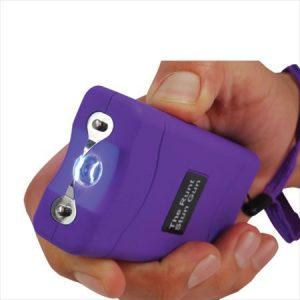Table of Contents
- Stun Gun Contact Basics Understanding Their Role and Importance
- Regular Cleaning Methods to Prevent Corrosion and Residue Build-Up
- Optimal Storage Conditions to Preserve Contact Integrity
- Troubleshooting Common Contact Issues for Reliable Performance
- Final Thoughts
Stun Gun Contact Basics Understanding Their Role and Importance
Stun gun contacts serve as the critical interface where electrical energy is transferred to the target, making their condition paramount for reliable self-defense tools. These contacts are typically composed of conductive metals designed to withstand substantial voltage and current without degradation. Over time, continuous use and exposure to environmental elements can cause corrosion, dirt buildup, and wear, significantly reducing their conductivity and, consequently, the stun gun’s effectiveness. Understanding the specific material properties and the operational mechanics of these contacts helps users appreciate the necessity for meticulous maintenance and inspection routines.
Key maintenance practices include:
- Regularly cleaning the contacts with a soft, dry cloth to remove debris and residue.
- Using 90% isopropyl alcohol sparingly for deeper cleaning without causing damage.
- Avoiding abrasive materials that could scratch or erode the contact surface.
- Inspecting contacts for visible signs of corrosion, discoloration, or physical deformation after each use.
By proactively caring for these detailed components, users ensure maximum electrical transfer efficiency and prolong their stun gun’s operational life. Such diligence not only enhances performance but also guarantees consistent reliability when the device is needed most.
Regular Cleaning Methods to Prevent Corrosion and Residue Build-Up
Maintaining your stun gun contacts in optimal condition requires consistent attention to cleaning. Begin by gently wiping the contacts with a soft, lint-free cloth dampened with isopropyl alcohol. This method effectively removes oils, dirt, and debris that accumulate with frequent use, reducing the risk of residue buildup that compromises electrical conductivity. Avoid abrasive materials or harsh solvents, as these can damage the metal surface or protective coatings. For stubborn grime, use a cotton swab dipped in alcohol to target hard-to-reach areas without causing harm. Always ensure the contacts are completely dry before reassembling or storing the device.
Incorporate preventive measures into your maintenance routine to inhibit corrosion and residue formation, such as:
- Regularly inspect contacts for signs of oxidation or discoloration.
- Apply a light coating of dielectric lubricant to guard against moisture and rust.
- Store the stun gun in a dry, temperature-controlled environment to avoid moisture exposure.
Optimal Storage Conditions to Preserve Contact Integrity
To ensure your stun gun contacts remain in top condition, it’s crucial to store the device in an environment that avoids extreme temperatures and humidity. Excessive moisture can cause corrosion, leading to diminished conductivity and performance issues. Ideally, keep your stun gun in a cool, dry place away from direct sunlight or heat sources. Using airtight containers or sealed pouches can further protect the contacts from airborne contaminants and dust particles that accelerate wear and degradation.
Proper storage also means minimizing physical contact with conductive materials, which might cause unwanted discharges or scratches on the contact points. Here are some best practices to follow:
- Store the stun gun with a safety cover or in its original holster
- Keep it separated from keys, coins, or metal objects
- Avoid prolonged exposure to salty or corrosive environments
- Periodically inspect the contacts and clean them before storing
Troubleshooting Common Contact Issues for Reliable Performance
To ensure your stun gun delivers maximum output, it’s essential to inspect the contacts regularly for signs of wear or debris. Dirty or corroded contacts can significantly reduce the device’s effectiveness, so start by cleaning them with a soft cloth slightly dampened with rubbing alcohol. Avoid abrasive materials that could scratch or damage the surface. Additionally, look out for any buildup of rust or oxidation, which often appears as a greenish or white residue. If stubborn deposits persist, use a cotton swab dipped in isopropyl alcohol to gently clean these areas, then dry thoroughly to prevent moisture-related malfunctions.
If the stun gun’s performance seems inconsistent, it might be a result of loose or misaligned contacts. Check for proper alignment by carefully examining the contact points and ensuring they are secure and making firm connections when the device is engaged. Loose contacts can often be remedied by gently tightening screws or adjusting contact arms as specified in your model’s manual. Remember to always power off the device before performing any checks or adjustments to avoid accidental discharge. Regular maintenance like this not only enhances reliability but also extends the lifespan of your stun gun.
Final Thoughts
Maintaining your stun gun contacts is a simple yet crucial step to ensure your device delivers peak performance when you need it most. By regularly cleaning and inspecting the contacts, protecting them from corrosion, and storing your stun gun properly, you can extend its lifespan and reliability. Remember, a well-maintained stun gun is your best line of defense-so don’t overlook these essential care tips. Stay safe and stay prepared!Check Our Other Blogs
- StunGun – Your Trusted Source for Stun Guns, Laws, and Self-Defense Tips
- PepperSprayLaws – Your Trusted Resource for Pepper Spray Information
- StunGunLaws – Your Trusted Guide to Stun Gun Legality and Safety





